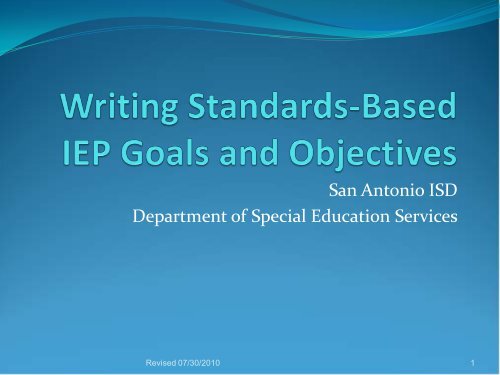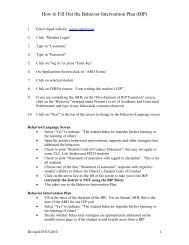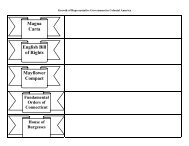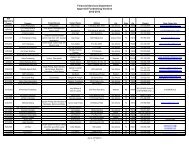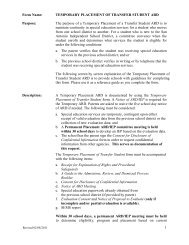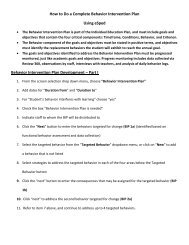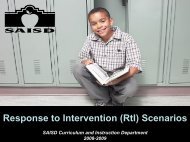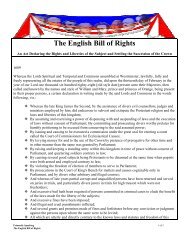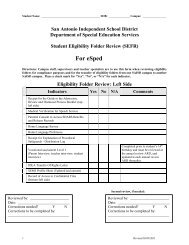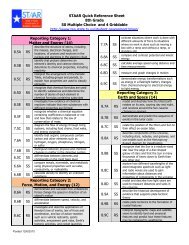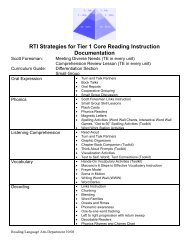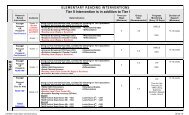Standards Based IEP Goals - San Antonio Independent School District
Standards Based IEP Goals - San Antonio Independent School District
Standards Based IEP Goals - San Antonio Independent School District
You also want an ePaper? Increase the reach of your titles
YUMPU automatically turns print PDFs into web optimized ePapers that Google loves.
<strong>San</strong> <strong>Antonio</strong> ISD<br />
Department of Special Education Services<br />
Revised 07/30/2010<br />
1
PLAAFP Basis<br />
• We must know the present levels of performance for a<br />
student before we can determine where we can<br />
reasonably expect him or her to be within twelve<br />
months.<br />
• Without the PLAAFP, the <strong>IEP</strong> does not have any data<br />
showing the student’s present levels of performance,<br />
and thus, cannot appropriately determine where the<br />
student’s needs currently exist.<br />
Revised 07/30/2010<br />
2
PLAAFP: 5 Essential Components<br />
• <strong>Based</strong> on Evaluation (Formal/Informal)<br />
• Classroom Data<br />
• Accommodations/Modifications<br />
• Parent Information<br />
• Additional Supports and Services<br />
Revised 07/30/2010<br />
3
PLAAFP Guiding Questions<br />
• Describe the individual strengths and needs of the<br />
student in relation to accessing and mastering the<br />
general curriculum by discussing the following:<br />
• What do we know about the student’s response to academic<br />
instruction (i.e., progress monitoring data)?<br />
• What programs, accommodations (classroom and testing)<br />
and/or interventions have been successful with the student?<br />
• What have we learned from previous <strong>IEP</strong>s and student data<br />
that can inform decision making?<br />
• Are there assessment data that can provide useful information<br />
for making decisions about the student’s strengths and needs<br />
(patterns in the data)?<br />
Revised 07/30/2010<br />
4
PLAAFP Guiding Questions<br />
• Consider the factors related to the student’s<br />
disability and how they affect how the student<br />
learns and demonstrates what he knows by asking<br />
the following:<br />
• How does the student’s disability affect participation and<br />
progress in the general curriculum?<br />
• What supports does the student need to learn the knowledge<br />
and attain the skills to progress in the general curriculum?<br />
• Is the student on track to achieve grade-level proficiency<br />
within the year?<br />
Revised 07/30/2010<br />
5
PLAAFP Process<br />
• Determine General Needs of the Student<br />
• Identify Critical Needs/Instructional Focus<br />
• Write Observable & Measurable <strong>IEP</strong> <strong>Goals</strong><br />
Revised 07/30/2010<br />
6
PLAAFP and Annual <strong>IEP</strong> <strong>Goals</strong><br />
• The PLAAFP and annual <strong>IEP</strong> goals must have a direct<br />
relationship.<br />
• Each area of need identified in the PLAAFP must be<br />
addressed somewhere in the <strong>IEP</strong>.<br />
• Most will be addressed by annual <strong>IEP</strong> goals, but they<br />
may be addressed or embedded in other ways.<br />
Revised 07/30/2010<br />
7
Annual • PLAAFP Connection <strong>Goals</strong>: Essential Elements<br />
• Parent Involvement<br />
• Meaningful<br />
• Measurable<br />
• Challenging<br />
• Realistic<br />
• Levels of Learning for students with Autism<br />
• Acquisition<br />
• Fluency<br />
• Maintenance<br />
• Generalization<br />
Revised 07/30/2010<br />
8
What are <strong>Standards</strong>-<strong>Based</strong> <strong>IEP</strong> <strong>Goals</strong>?<br />
• <strong>Standards</strong>-based goals are annual, measurable goals<br />
aligned to enrolled grade-level Texas Essential<br />
Knowledge and Skills (TEKS).<br />
Revised 07/30/2010<br />
9
What does aligned to enrolled grade-level TEKS<br />
mean?<br />
• Should reflect and link directly to specific grade-level<br />
TEKS<br />
• Does not need to include all TEKS<br />
• Should include only the most critical student<br />
expectations within a specific content domain<br />
Revised 07/30/2010<br />
10
What are standards-based measurable annual<br />
goals?<br />
• Statements that describe what can reasonably be expected<br />
to accomplish within an <strong>IEP</strong> year<br />
• Skills and/or knowledge that will be mastered, not an<br />
activity<br />
• Contain four critical components: timeframe,<br />
conditions, behavior, and criterion<br />
• Includes the behavior or skill that can be measured at<br />
periodic intervals against a criterion of success<br />
Revised 07/30/2010<br />
11
What should the ARD committee consider to ensure<br />
that standards-based <strong>IEP</strong> goals are measurable?<br />
• A standards-based measurable goal meets the<br />
following requirements:<br />
• Indicates what to do to measure accomplishment of the<br />
goal<br />
• Yields the same conclusion if measured by several<br />
people<br />
• Allows a calculation of how much progress it represents<br />
• Can be measured without additional information and<br />
within a 12 month period<br />
Revised 07/30/2010<br />
12
7 Steps to Writing <strong>IEP</strong> <strong>Goals</strong><br />
Step 7<br />
State<br />
Assessment<br />
Step 1<br />
Consider<br />
Grade Level<br />
Content<br />
Step 2<br />
Exam the<br />
Data<br />
Step 6<br />
Accom./<br />
Mod,<br />
Student<br />
Step 3<br />
Develop<br />
PLAAFP<br />
Step 5<br />
Assess and<br />
Report<br />
Progress<br />
Step 4<br />
Develop<br />
Measurable<br />
Annual<br />
<strong>Goals</strong><br />
Revised 07/30/2010<br />
13
7 Steps to Writing <strong>IEP</strong> <strong>Goals</strong><br />
• Step 1: Consider Grade Level Content<br />
• Step 2: Exam the Data<br />
• Step 3: Develop the PLAAFP (baseline data)<br />
• Step 4: Develop Measurable Annual <strong>Goals</strong><br />
• Step 5: Assess and Report Progress<br />
• Step 6: Accommodations/Modifications<br />
• Step 7: State Assessment<br />
Revised 07/30/2010<br />
14
When does an ARD committee need to develop<br />
annual goals? When…<br />
• the ARD committee has assigned the student modified<br />
content (regardless of setting).<br />
• the ARD committee removes the student from a<br />
general education setting.<br />
• the ARD committee has not modified content and has<br />
not removed the student from a general education<br />
setting.<br />
Revised 07/30/2010<br />
15
When does an ARD committee need to develop<br />
annual goals?<br />
• The ARD committee removes the student from a<br />
general education setting. Whether or not the content<br />
is modified, if the student is removed from a general<br />
education setting, an annual goal is needed for that<br />
specific content area/course.<br />
Revised 07/30/2010<br />
16
When does an ARD committee need to develop<br />
annual goals?<br />
• If a student has no modified content and is not<br />
removed from a general education setting, the ARD<br />
committee must still include measurable annual goals.<br />
Annual goals may:<br />
• --Be developed from an area of need addressed in the<br />
student’s PLAAFP that affects the student’s ability to<br />
make progress and/or access the general education<br />
curriculum; and/or<br />
• --Be developed to clearly defined specially designed<br />
instruction that the student will receive.<br />
Revised 07/30/2010<br />
17
<strong>IEP</strong> <strong>Goals</strong>: Four Components<br />
• Timeframe: specifies the amount of time in the goal<br />
period, i.e. 36 weeks<br />
• Conditions: specifies the manner in which progress<br />
toward the goal is measured and involves the<br />
application of skills or knowledge<br />
• Behavior: clearly identifies the performance which is<br />
being monitored; reflects an action which can be<br />
directly observed<br />
• Criterion: identifies how much, how often, or to what<br />
standards the behavior must occur in order to<br />
demonstrate that the goal has been achieved.<br />
Revised 07/30/2010<br />
18
What does a standard-based measurable goal<br />
look like?<br />
• 3 rd Grade ELA TEKS (6)(B) –<br />
The student reads with fluency<br />
and understanding in texts at<br />
appropriate difficultly levels.<br />
The student is expected to<br />
read regularly in instructionallevel<br />
materials that are<br />
challenging but manageable<br />
(texts in which approximately<br />
no more than 1 in 10 words is<br />
difficult for the reader; the<br />
typical third grader reads 80<br />
wpm.)<br />
• In 36 instructional<br />
weeks using decoding<br />
skills and oral practice<br />
within a 3 rd grade<br />
passage Joseph, a 3 rd<br />
grade student, will<br />
read 70 words per<br />
minute with 7 or fewer<br />
errors.<br />
Revised 07/30/2010<br />
19
What does a standard-based measurable goal<br />
look like?<br />
• 5 th Grade ELA TEKS 5.18 A(iv)<br />
– Students write expository<br />
and procedural or work related<br />
texts to communicate ideas<br />
and information to specific<br />
audiences for specific<br />
purposes. Students are<br />
expected to: (A) create multiparagraph<br />
essays to convey<br />
information about the topic<br />
that: (iv) use a variety of<br />
sentence structures and<br />
transitions to link paragraphs;<br />
• By May 15, 2010, given a<br />
5 th grade story prompt<br />
and 30 minutes to<br />
write Linda, a 5 th grade<br />
student, will write a<br />
three paragraph essay<br />
using transition words<br />
in sentences and<br />
between paragraphs<br />
with 5 or fewer errors.<br />
Revised 07/30/2010<br />
20
What does a standard-based measurable goal<br />
look like?<br />
• 6 th Grade Math TEKS (6.2)(B)<br />
– The student adds, subtracts,<br />
multiplies, and divides to solve<br />
problems and justify solutions.<br />
The student is expected to use<br />
addition and subtraction to<br />
solve problems involving<br />
fractions and decimials.<br />
• By the end of the 2009-<br />
2010 school year given<br />
mixed fraction<br />
problems using<br />
addition and<br />
subtraction Jose, a 6 th<br />
grade student will<br />
solve 85% of all<br />
assigned problems<br />
correctly.<br />
Revised 07/30/2010<br />
21
What are Functional <strong>IEP</strong> <strong>Goals</strong>?<br />
• The term is generally referred to skills or activities that<br />
are not considered academic or related to a child’s<br />
academic achievement. Instead it is used in the<br />
context of routine activities of everyday living.<br />
Revised 07/30/2010<br />
22
Examples of Functional Skills<br />
and Behaviors<br />
Examples: Social, emotional, communication and<br />
executive skills (time management, selfadvocacy/determination),<br />
and behaviors.<br />
• The amount of time a student can remain on task<br />
• The number of times a student raises his/her hand<br />
• The amount of time it takes for a student to begin work on an<br />
assignment after the teacher gives directions<br />
• The amount of time a student is rocking with a certain timeframe<br />
• The number of times a student brings his/her notebook, textbook,<br />
and pencil to class<br />
Revised 07/30/2010<br />
23
What does a Functional <strong>IEP</strong> Goal look like?<br />
• During the instructional school year, using a<br />
planner to record assignments, when directed by<br />
classroom teachers, Allison, a senior in high<br />
school, will complete planner entries in core<br />
content areas correctly and on time in 3 out of 5<br />
class periods.<br />
Revised 07/30/2010<br />
24
What does a Functional Goal look like?<br />
• By the end of the <strong>IEP</strong> year, when given a built-up<br />
spoon Jessica will self-feed with minimal spillage 4 out<br />
of 5 trials.<br />
Revised 07/30/2010<br />
25
What is a Post-Secondary Goal(s)?<br />
• For each post-secondary goal there must be an annual<br />
goal(s) included in the <strong>IEP</strong> that will help the student<br />
make progress towards the stated post-secondary<br />
goal(s).<br />
Revised 07/30/2010<br />
26
Example: Post-secondary Goal<br />
• Jason will earn his undergraduate degree in history<br />
and education, to become a high school social studies<br />
teacher.<br />
Revised 07/30/2010<br />
27
What does facilitated movement towards a postsecondary<br />
<strong>IEP</strong> goal look like?<br />
Academic<br />
• Within 36 instructional<br />
weeks, given in class<br />
assignments Jason, a 12 th<br />
grade student, will<br />
accurately apply algebraic<br />
formulas 8 out of 10 trials.<br />
• During the instructional<br />
school year, when<br />
presented with<br />
information by his<br />
academic counselor Jason,<br />
a 12 th grade student, will<br />
participate in the district’s<br />
teacher mentor program,<br />
meeting the attendance<br />
and performance criteria of<br />
the program through June<br />
4, 2010.<br />
Functional<br />
Revised 07/30/2010<br />
28
Related Service Goal for Counseling<br />
• In six counseling sessions, John will utilize positive<br />
self-talk and calming strategies to handle stressful or<br />
feared situations in which he manifests anxious<br />
behavior (e.g. tearing up papers, mumbling under his<br />
breath, etc.). This will be demonstrated by engaging<br />
in the activity or situation in a calm manner two out of<br />
three incidents.<br />
Revised 07/30/2010<br />
29
How can ARD committees use the TEKS to write<br />
standards-based goals?<br />
• The student expectation component of the TEKS is<br />
used to provide the framework for annual goal writing<br />
by establishing grade-level expectations.<br />
• Student expectations alone are not measurable and<br />
must be crafted by the ARD committee to reflect a<br />
measurable annual goal.<br />
Revised 07/30/2010<br />
30
Can ARD committees use TAKS-Alt Essence<br />
Statements to write standards-based <strong>IEP</strong> goals?<br />
• Yes, each knowledge and skill statement has been<br />
summarized into an essence statement that serves as a<br />
link to the grade-level TEKS.<br />
• Essence statements alone are not measurable and<br />
must be crafted by ARD committees to reflect a<br />
measurable annual goal.<br />
Revised 07/30/2010<br />
31
What do standards-based measurable annual<br />
<strong>IEP</strong> goals look like using TAKS-Alt Essence<br />
Statements?<br />
• TEKS (4.12) Measurement. The<br />
student applies measurement<br />
concepts. The student measures time<br />
and temperature (in degrees<br />
Fahrenheit and Celsius). The student<br />
is expected to: (A) use a thermometer<br />
to measure temperature and changes<br />
in temperature.<br />
• Goal: By May 15, 2010 given a<br />
Fahrenheit thermometer and liquids<br />
of different temperatures Lisa, a 4 th<br />
grade student, will give the correct<br />
measurement of temperature in<br />
degrees Fahrenheit on 7 of 10<br />
assigned problems.<br />
• TAKS –Alt: Essence<br />
Statement: Understands<br />
temperatures and time.<br />
• Goal: By May 15, 2010 given four<br />
objects of different temperatures<br />
Cindy a 4 th grade student, will<br />
categorize temperatures of objects by<br />
identifying the cold object and the<br />
warm object 7 out of 10 trials.<br />
32<br />
Revised 07/30/2010
When are Benchmarks/Short-Term Objectives<br />
needed?<br />
• This depends on the scope of annual goals and the<br />
needs of each individual student, based on ARD<br />
committee decision<br />
• They are required as part of the annual goal for<br />
any student taking an alternate assessment judged<br />
against alternate achievement standards such as<br />
TAKS-Alt (IDEA 300.320 (a)(2)(i)).<br />
• Per the state of Texas, two objectives per each<br />
annual goal must be developed.<br />
Revised 07/30/2010<br />
33
What are Benchmark/Short-Term Objectives?<br />
• Benchmarks/Short-term objectives describe the steps<br />
to be taken between the child’s present levels of<br />
academic achievement and functional performance<br />
and the attainment of the annual goal.<br />
• Like the annual goal, benchmarks/short-term<br />
objectives must include timeframe, conditions,<br />
behavior and criterion.<br />
Revised 07/30/2010<br />
34
What are Benchmark/Short-Term Objectives?<br />
• There should be at least two benchmarks/short term<br />
objectives for each <strong>IEP</strong> goal for students with an<br />
modified curriculum and taking TAKS-M, and for<br />
students with an alternate curriculum and taking<br />
TAKS-Alt.<br />
• When considering frequency and duration, specify the<br />
time that will be used for purposes of accountability<br />
and progress monitoring.<br />
Revised 07/30/2010<br />
35
Examples of <strong>Goals</strong> and Objectives<br />
• Goal: By the end of the <strong>IEP</strong> year,<br />
during structured play, Austin<br />
makes the sound of an animal or<br />
vehicle, or some other<br />
environmental sound .<br />
• Objective: By the end of the<br />
first grading period per annual,<br />
during structured play, Austin<br />
makes the sound of farm<br />
animals (cow, pig, sheep, dog,<br />
cat) in 3 of 5 trials.<br />
• Objective: By the end of the<br />
second grading period per<br />
annual, during structured play,<br />
Austin makes the environmental<br />
sound of phone ringing, door<br />
bell, clock ticking in 3 of 5 trials.<br />
Revised 07/30/2010<br />
36
Examples of <strong>IEP</strong> <strong>Goals</strong> and Objective<br />
• TEKS: Austin is expected to<br />
generate a fraction equivalent to a<br />
given fraction such as 1/2 and 3/6 or<br />
4/12 and 1/3.<br />
111.17.5.2.A<br />
• <strong>Standards</strong>-<strong>Based</strong> Goal: By June 04,<br />
2010, when given a class assignment,<br />
Austin will generate a fraction<br />
equivalent to a given fraction such<br />
as ½ and 3/6 or 4/12 and 1/3 with<br />
70% accuracy.<br />
• Modified Goal: By June 04, 2010,<br />
when given a class assignment,<br />
Austin will generate a fraction<br />
equivalent to a given fraction such<br />
as ½ and 3/6 or 4/12 and 1/3 with 60<br />
% accuracy.<br />
• Objective: By the end of the first<br />
grading period per annual, when<br />
given a class assignment, Austin will<br />
generate a fraction equivalent to a<br />
given fraction of ½ with 60 %<br />
accuracy.<br />
Revised 07/30/2010<br />
37
Examples of <strong>IEP</strong> <strong>Goals</strong> and<br />
Objective<br />
• TEKS Standard:T he student is<br />
expected to identify forces that<br />
shape features of the Earth<br />
including uplifting, movement of<br />
water, and volcanic activity.<br />
112.22.6.6.C (TEKS)<br />
• <strong>Standards</strong>-<strong>Based</strong> Goal: By the end<br />
of the current school year, when<br />
given grade level classroom<br />
assignments, Austin will identify<br />
forces that shape features of the<br />
Earth including uplifting,<br />
movement of water, and volcanic<br />
activity with 70% accuracy.<br />
• Modified Goal: By the end of the<br />
current school year, when given<br />
grade level classroom assignments,<br />
Austin will identify forces that<br />
shape features of the Earth<br />
including uplifting, movement of<br />
water, and volcanic activity with<br />
65% accuracy.<br />
• Objective: By the end of the<br />
current school year, when given<br />
grade level classroom assignments,<br />
Austin will identify forces that<br />
shape features of the Earth<br />
including movement of water, with<br />
65% accuracy.<br />
Revised 07/30/2010<br />
38
Examples of <strong>IEP</strong> <strong>Goals</strong> and<br />
Objectives<br />
• TEKS Standard: The student is<br />
expected to edit drafts for grammar,<br />
mechanics, and spelling.<br />
110.31.9.13.D (TEKS)<br />
• <strong>Standards</strong>-<strong>Based</strong> Goal Example: By<br />
the end of the current school year, when<br />
given a writing assignment, Austin will<br />
edit drafts for correct grammar,<br />
mechanics, and spelling with 80%<br />
accuracy.<br />
• Modified Goal Example: By the end of<br />
the current school year, when given a<br />
writing assignment, Austin will edit<br />
drafts for correct grammar, mechanics,<br />
and spelling with 60% accuracy.<br />
• Objective: By the end of the first<br />
grading period per annual, when given a<br />
writing assignment, Austin will edit<br />
drafts for correct grammar with 60%<br />
accuracy.<br />
• Objective: By the end of the second<br />
grading period per annual, when given a<br />
writing assignment, Austin will edit<br />
drafts for correct mechanics with 60%<br />
accuracy.<br />
• Objective: By the end of the third<br />
grading period per annual, when given a<br />
writing assignment, Austin will edit<br />
drafts for correct spelling with 60%<br />
accuracy.<br />
Revised 07/30/2010<br />
39
Department of Special Education Services Policy<br />
• Students taking TAKS and TAKS-Accommodated need<br />
<strong>Goals</strong><br />
• Students taking a TAKS-M and a TAKS-Alt need <strong>Goals</strong><br />
and Benchmarks/Short-term objectives.<br />
Revised 07/30/2010<br />
40
What is Progress Monitoring?<br />
• Progress monitoring is when teachers assess student’s<br />
academic performance on a regular basis (daily, weekly<br />
or monthly – contingent upon program placement) for<br />
two purposes:<br />
• --to determine whether children are profiting<br />
appropriately from the typical instructional program.<br />
• --to build more effective programs for the children<br />
who benefit inadequately from typical instruction.<br />
Revised 07/30/2010<br />
41
PLAAFP and Progress Monitoring<br />
• PLAAFPs establish the starting points in developing<br />
annual goals and serve as a baseline data points.<br />
• Through a systematic approach to progress<br />
monitoring, the effectiveness of instructional services<br />
can be determined.<br />
Revised 07/30/2010<br />
42
Measuring Student Progress<br />
• One must use the same methods that were used to<br />
measure the child’s achievement in the PLAAFPs when<br />
assessing progress on the annual goals and/or short<br />
term objectives.<br />
• The key to progress monitoring is consistency.<br />
• Progress monitoring results inform and help ARDC<br />
members make good instructional decisions for<br />
students.<br />
Revised 07/30/2010<br />
43
Tough Questions From the Field<br />
(TQFF)<br />
Revised 07/30/2010<br />
44


